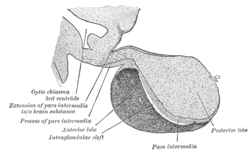Pars intermedia
| Pars intermedia | |
|---|---|
 Median sagittal through the hypophysis of an adult monkey. (Pars intermedia labeled at bottom center.) | |
| Details | |
| Identifiers | |
| Latin | pars intermedia adenohypophysis |
| TA98 | A11.1.00.004 A09.4.02.017 |
| TA2 | 3858 |
| TH | H3.08.02.2.00007 |
| FMA | 74632 |
| Anatomical terminology | |

The pars intermedia is the middle lobe of the pituitary gland between the anterior lobe, and the posterior lobe.[1] The pars intermedia secretes α-melanocyte-stimulating hormone (α-MSH), and corticotropin-like intermediate peptide.[citation needed] The intermediate lobe is a small region that is largely without blood supply.[2] It appears to be tonically inhibited by the hypothalamus.
In human fetal development, this area produces melanocyte stimulating hormone (MSH) which causes the release of melanin produced in melanocytes that can give a darker skin pigmentation. In the adult the pars intermedia is either very small or entirely absent.
In less developed vertebrates the pars intermedia is much larger, and structurally and functionally more well defined.[3] In some animals including amphibians[4] it mediates active camouflage, causing darkening of the skin when placed against a darker background.
Anatomy
[edit]Microanatomy
[edit]It contains colloid-filled cysts and two types of cells - basophils and chromophobes. The cysts are the remainder of Rathke's pouch. As technically part of the anterior pituitary, it separates the posterior pituitary and pars distalis. It is composed of large, pale cells that encompass the aforementioned colloid-filled follicles.[5]
Physiology
[edit]The pars intermedia appears to be tonically inhibited by stimuli from the hypothalamus (either by dopaminergic innervation or by vascular mechanism) as experimental sectioning of the pars intermedia from the hypothalamus has been noted to result in hypertrophy of the pars intermedia in various animals.[4]
Function
[edit]The pars intermedia is responsible for secreting α-melanocyte-stimulating hormone, and corticotropin-like intermediate peptide.[4]
It is prominent only during the fetal stage and is otherwise negligible. The characteristic pattern of skin hyperpigmentation seen during pregnancy may be a result of increased circulating maternal a-MSH (which may have originated from either the maternal or fetal pars intermedia), but a-MSH secretion does not seem to be involved in skin tanning in response to light exposure.[4]
Other animals
[edit]In lower vertebrates (fish, amphibians), MSH from the pars intermedia is responsible for darkening of the skin, often in response to changes in background color.[citation needed] This color change is due to MSH stimulating the dispersion of melanin pigment in the animal's skin melanocyte chromatophores. Some animals will thus increase a-MSH secretion when placed against a dark background[4] as a means of active camouflage.
References
[edit]- ^ Ganapathy, MK; Tadi, P (January 2024). Anatomy, Head and Neck, Pituitary Gland. PMID 31855373.
- ^ Hall, John E.; Guyton, Arthur C. (2011). Guyton and Hall textbook of medical physiology (12th ed.). Philadelphia, Pa: Saunders/Elsevier. p. 895. ISBN 9781416045748.
- ^ Hall, John E.; Guyton, Arthur C. (2011). Guyton and Hall textbook of medical physiology (12th ed.). Philadelphia, Pa: Saunders/Elsevier. p. 935. ISBN 9781416045748.
- ^ a b c d e Davies, Andrew; Blakeley, Asa G. H.; Kidd, Cecil, eds. (2001). Human Physiology. pp. 397–398. ISBN 978-0-443-04559-2.
- ^ Ilahi, Sadia; Ilahi, Tahir B. (3 October 2022). "Anatomy, Adenohypophysis (Pars Anterior, Anterior Pituitary)". Anatomy, Adenohypophysis (Pars Anterior, Anterior Pituitary). StatPearls Publishing. Retrieved 9 February 2023.
External links
[edit]- Histology image: 14001loa – Histology Learning System at Boston University
- Histology image: 14101loa – Histology Learning System at Boston University
- Histology image: 38_11 at the University of Oklahoma Health Sciences Center
- UIUC Histology Subject 991
